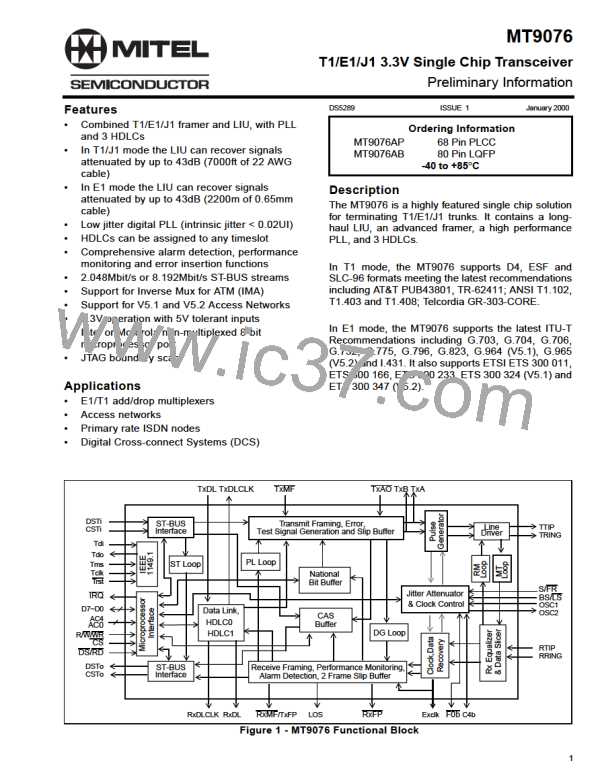MT9076
Preliminary Information
Bit
Name
Functional Description
7
6
5
DSToEn DSTo Enable. If zero pin DSTo is tristate. If set the pin DSTo is enabled.
CSToEn CSTo Enable. If zero pin CSTo is tristate. If set the pin CSTo is enabled.
RBEn
DBEn
MSN
Robbed Bit signaling Enable. Setting this bit multiplexes the AB or ABCD signaling bits into
bit position 8 of all DS0 channels every 6th frame.
4
3
Debounce Enable. Setting this bit causes incoming signaling bits to be debounced for a
period of 6 to 9 milliseconds before reporting on CSTo or in the Receive signaling Bits Page.
Most Significant Nibble. If set to one the most significant nibble of CSTi and CSTo are
activated. The reporting stream CSTo contains the signaling information for the equivalent
channel in the most significant nibble, and least significant nibble is tristate. If set to zero the
least significant nibble is active for CSTi and CSTo and the most significant nibble of CSTo is
tristate.
2-1
SM1-0
JYEL
signaling Message. These two bits are used to fill the vacant bit positions available on CSTo
when the 3VJET is operating on a D4 trunk. The first two bits of each reporting nibble of
CSTo contain the AB signaling bits. The last two will contain SM1 and SM0 (in that order).
When the 3VJET is connected to ESF trunks four signaling bits (ABCD) are reported and the
bits SM1-0 become unused.
0
Japan Yellow Alarm Set this bit high to selects a pattern of 16 ones (111111111111111) as
the ESF yellow alarm, both for the case when an ESF yellow alarm is to be transmit, or in
recognizing a received yellow alarm.
Table 25 - signaling Control Word (T1)
(Page 1, Address 14H)
Bit
Name
Functional Description
7
6
RxB8ZS Receive B8ZS Enable. If one, receive B8ZS decoding is enabled.
MLBK
Metallic Loopback. If one, then RRTIP/RRING are connected directly to TTIP and TRING
respectively. If zero, then this feature is disabled.
5
4
TxB8ZS Transmit B8ZS Enable. If one, all zero octets are substituted with B8ZS codes.
FBS
Forced Bit Stuffing. If set any transmit DS0 channel containing all zeros has bit 7 forced
high.
3
DLBK
Digital Loopback. If one, then the digital stream to the transmit LIU is looped back in place
of the digital output of the receive LIU. Data coming out of DSTo will be a delayed version of
DSTi. If zero, this feature is disabled.
2
1
0
RLBK
SLBK
PLBK
Remote Loopback. If one, then all time slots received on RRTIP/RRING are connected to
TTIP/TRING on the DS1 side of the 3VJET. If zero, then this feature is disabled.
ST-BUS Loopback. If one, then all time slots of DSTi are connected to DSTo on the ST-BUS
side of the 3VJET. If zero, then this feature is disabled. See Loopbacks section.
Payload Loopback. If one, then all time slots received on RTIP/RRING are connected to
TTIP/TRING on the ST-BUS side of the 3VJET. If zero, then this feature is disabled.
Table 26 - Coding and Loopback Control Word (T1)
(Page 1, Address 15H)
62

 MITEL [ MITEL NETWORKS CORPORATION ]
MITEL [ MITEL NETWORKS CORPORATION ]